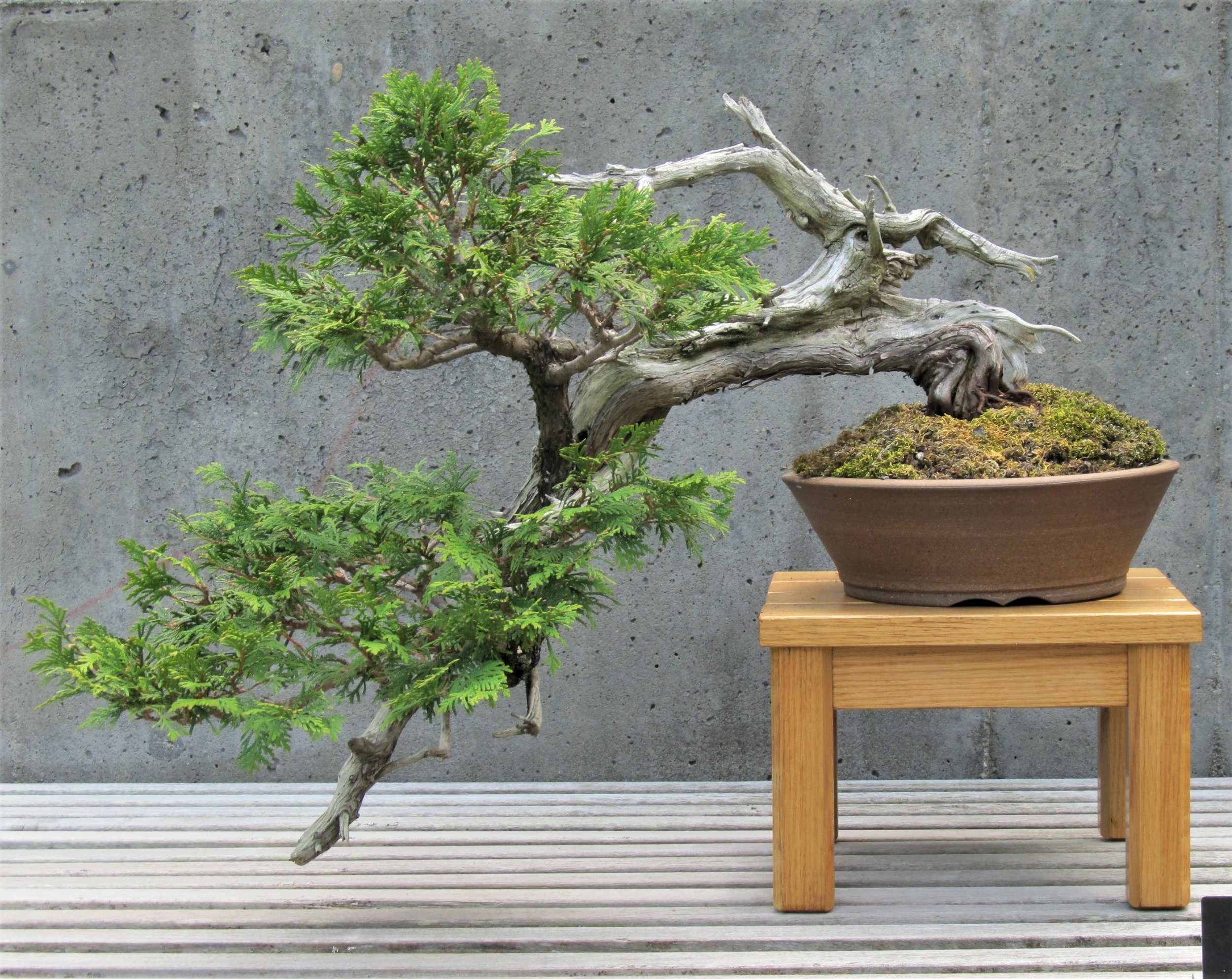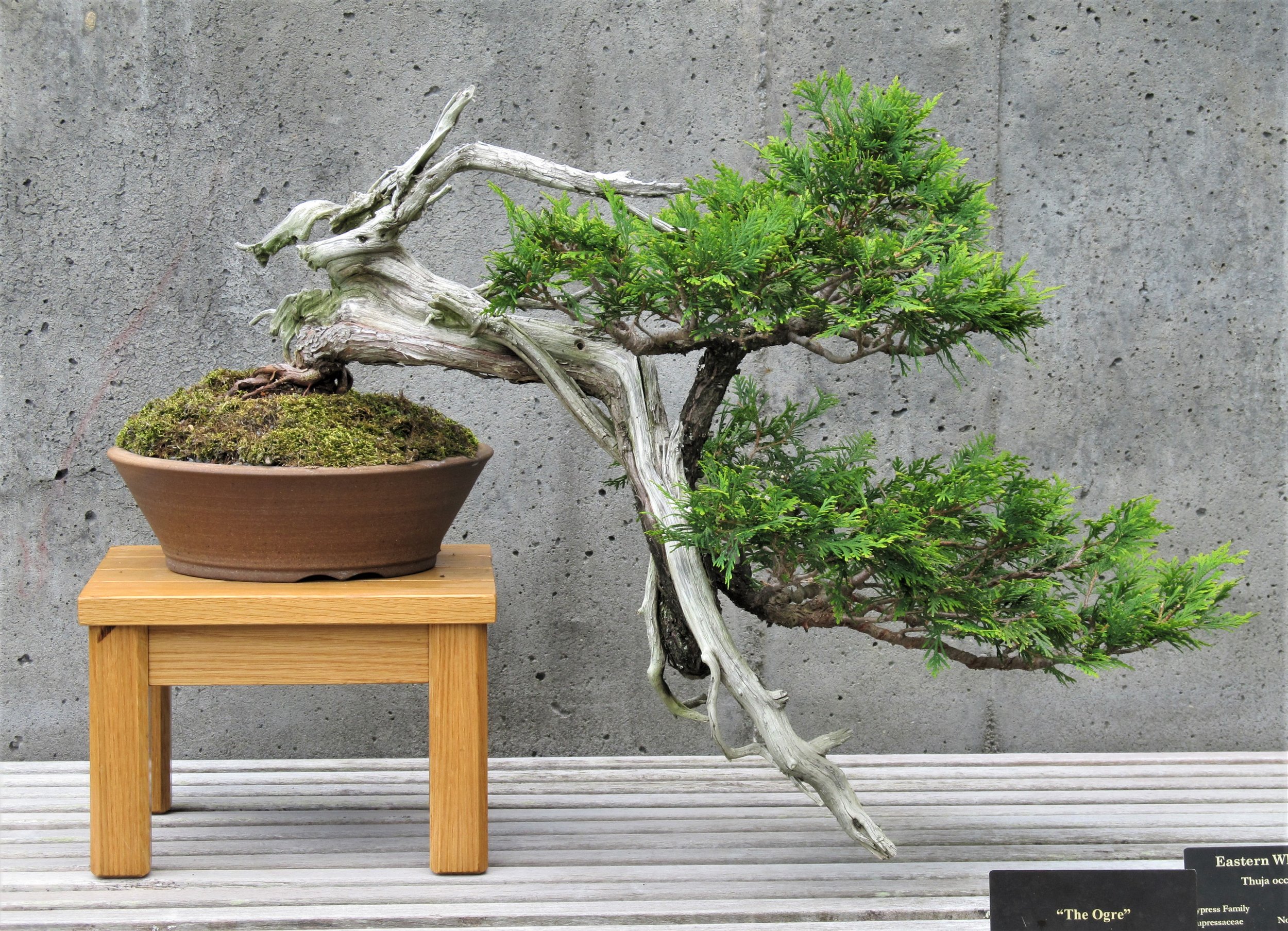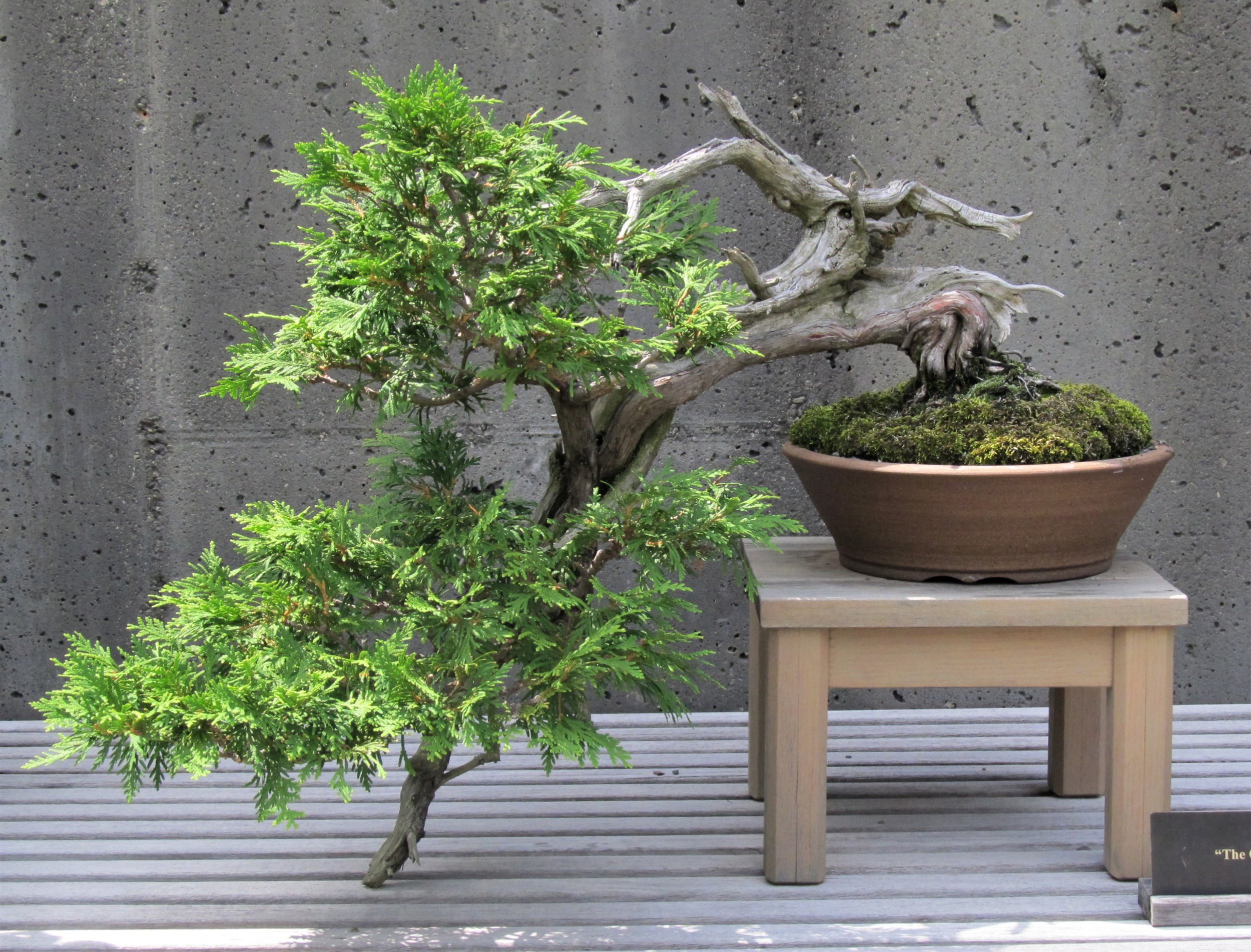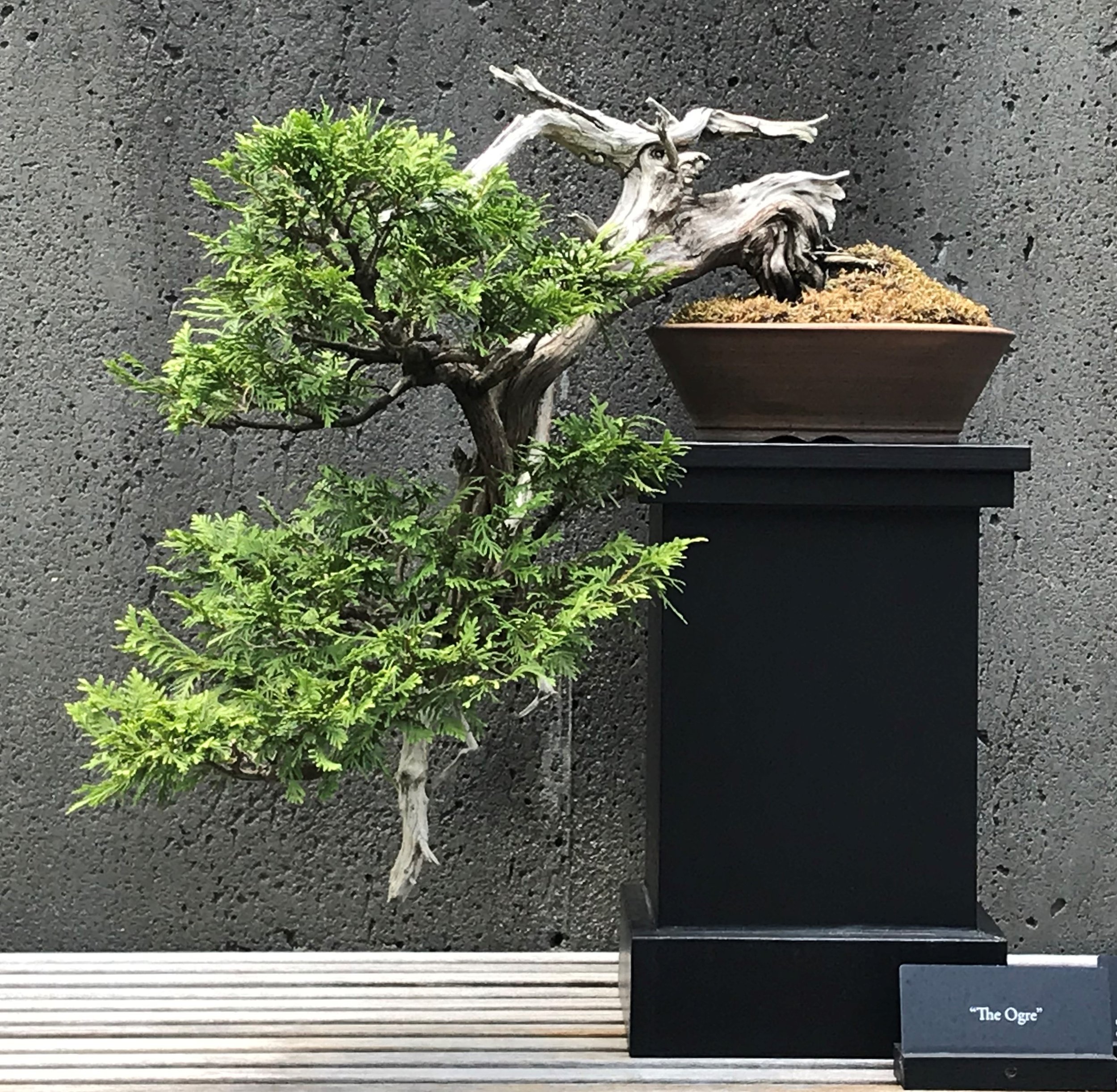The Ogre
The thirteenth Carolina Bonsai Expo was held in 2008, and, as befitted its association with such a superstitious number, that year's event was unlucky from the beginning.
Sometime well beforehand I learned the first US National Bonsai Exhibition was scheduled for the same October weekend as the Expo, the same time slot the Expo had occupied for a dozen years prior. US National Bonsai Exhibition organizer Bill Valavanis had contacted me before announcing the dates for the new event to give a heads-up about it, explaining that circumstances dictated having the show that weekend and he was sorry for the conflict. For a brief time I considered pushing the Expo date back until later in the month but then thought better of it. The Expo was a well-established annual event and we had a loyal following, and there was some reason to think another bonsai show, even a national one, being held as far away as Rochester, New York, might not have any noticeable effect on our attendance. Still, I thought it might be prudent for us to have an extra-special guest artist for our event, just to make attending it more enticing.
There was one bonsai artist I had long wanted to have at the Carolina Bonsai Expo but always hesitated to approach. Andrew “Nick” Lenz was legendary in bonsai circles back then — and notorious, as well. Nick was undeniably a unique, innovative, creative force who shaped and presented his little trees in ways no one had ever thought of before. He took the idea of root-over-rock and turned it into root-over-statuary. He sometimes incorporated the dismembered parts of baby dolls into his bonsai design. He carved grotesques into the deadwood of some of his trees. He created a perfect little forest scene and then made his own miniature model of a World War II German Panzer tank to have rolling right through the middle of it. Nick could do straight-up bonsai as well, excellent naturalistic work, mostly from wild plant material he collected himself. He was an author, too. His book Bonsai From the Wild focused on collecting and working with native plant material, serving as something of a bible for an earlier generation of bonsai growers who were attracted to that subject. Nick also worked in clay, creating distinctively weird decorative items but also fine bonsai pottery.
Given his credentials, you would have expected Nick Lenz to be one of the more popular guest artists on the bonsai scene. He did turn up here and there as a presenter, but by the time the Arboretum’s bonsai program began coming into its own Nick had become fairly rare. He seemed to be someone more talked about than ever encountered at a symposium or convention. His talent was generally acknowledged and respected, but there were whispers about him being "difficult." To be honest, some people thought Nick an outrageous crank and they didn't bother to whisper when they described him as being more along the lines of "crazy." His friends might describe him as irascible, then shrug, roll their eyes and say, "Well, that's Nick... " His friends were the ones who nicknamed him "The Ogre."
I hadn’t met Nick Lenz. My bonsai friend Jim Doyle, of Nature's Way Nursery in Pennsylvania, was a friend of Nick's and visited him at his house in rural Massachusetts sometimes. Jim gave me Nick's email address and I wrote to Nick Lenz to ask him if he'd consider being guest artist at the thirteenth Carolina Bonsai Expo. To my surprise, he accepted.
What followed was an exchange of email over the span of the first nine months of 2008, in which I attempted to get some kind of handle on the person I had invited to be headliner of our event. I was a little anxious because I had heard stories about Nick's exploits as a guest artist at other bonsai events. I had heard that one time he was giving a slide presentation to a roomful of people and the first image he projected on the screen showed himself running naked in the woods. I heard he sometimes turned snarly toward people who annoyed him. I was leery about how Nick's eccentricities would play before an Expo audience.
In my correspondence with him, consisting of maybe ten messages back and forth, I found Nick Lenz to be educated, sharp, witty and ultimately charming, in a cantankerous sort of way. In my estimation he was a good writer, and I looked forward to reading his letters. They seemed like letters more than simply email messages because of the way he wrote them, poetically expressed, colorful and creative in thought. Under their influence my initial doubt about Nick as a guest artist gave way to an eagerness to meet him and get to know him better. Meanwhile, his notoriety was generating plenty of interest among bonsai people who knew he was coming to the Expo. A month or so before the weekend of the event, when we released information about Nick's demonstration program and the workshop he would teach, the available spaces filled immediately. All seemed to be coming together perfectly.
Then the thirteenth jinx raised its head. One morning, just a few weeks out from Expo weekend, I came in to work to find a message from Nick waiting on my computer. This message was very brief. It said: "Something's come up, can't make it. Suggest you get Jimmy John as replacement." (Jimmy John was what Nick called Jim Doyle.) That was the entire message. I couldn't believe it. I wrote back, "You're kidding, right?" A short while later an email came from someone identifying himself as Nick's son, and he assured me it was no joke. His father had experienced a serious coronary episode and was taken to the hospital for examinations and observation.
How it played out after that — the woebegone tale of the thirteenth Expo — is a different story altogether and will perhaps be told some other day. The bottom line is that Nick Lenz never made it to The North Carolina Arboretum, and I never got to meet him. He survived that 2008 scare but his health would be an issue until his death in 2022. He did, however, through the agency of Jim Doyle, send along a donation to the Arboretum's bonsai collection. I suppose the tree was a consolation for the trouble caused by the guest artist bailing out at the last minute. Anyway, it was how we became the proud owners of our own Nick Lenz original:
The above photo shows a Northern Whitecedar (Thuja occidentalis), collected from the wild by Nick, from a crevice in a rock outcrop on the shores of an Adirondack lake. He designed the bonsai, which involved bending a long, straight, stiff branch into a shape like a hairpin. Nick made the container, too. The image captures the tree as it appeared in October of 2009, less than a year from the date we received it. This bonsai does not feature any of the unusual embellishments for which Nick Lenz was so well known, but it is a nice piece of tricky work and includes deadwood that has its own ruggedly grotesque nature:
It might be supposed by people who don't know the backstory that this specimen was given the poetic name The Ogre in reference to the gnarly features of the deadwood, which can be read as a monstrous creature with one small, beady eye glaring out. But really it was named for the person who collected, styled and donated the little tree to our collection: Nick Lenz, the original wild man of American bonsai. If he was really an ogre himself, it must only have been at certain times.
The Ogre in December of 2009. This specimen joined a small handful of others in the Arboretum collection designated as sufficiently hardy to be left out on display all winter. The dark brownish-olive foliage color is common to numerous coniferous species during cold weather.
2011
The Ogre served as the logo tree for the 2011 Carolina Bonsai Expo.
The two pictures below offer a contrast in presentation. In bonsai there is usually a preferred viewing angle for any given tree, and in this instance the preferred view is pictured on the left. The tree can be, and has been, shown from the opposite perspective, as seen in the picture on the right. Which view is better? It is a matter of opinion and the person showing the tree makes the decision (click on either image for full view):
The Ogre is the only northern whitecedar in the Arboretum’s bonsai collection and that makes it distinctive. It is also one of the few recumbent form bonsai we have, in addition to being a collected specimen — another comparative rarity for us. However, the most notable aspect of The Ogre, the source of its greatest value, is its connection to Nick Lenz. Maintaining that connectivity is desirable, so a conscious effort is made to remain true to the original design intent. Despite that effort, one significant change has occurred. Over the years, compelled by the force of gravity, the angle of the trunk has dropped. The tree has become more recumbent. The first few times The Ogre was repotted the trunk was adjusted back to the position it had when the bonsai was received in donation. Before long the trunk line would invariably begin to descend once more. In the picture below the tip of the descending line is actually resting on the display bench:
2017
In 2018 I made the decision to go with the tree’s inclination to descend. The adjustment required a new and taller table to be built for the tree to sit upon, so that the tip of the descending trunk line was elevated off the bench. This alteration of posture was a matter of practicability rather than a desire to change the look of the specimen. In all other regards Nick Lenz’s original design is still very much in evidence, the most notable alterations having come about in the natural course of the tree becoming older. The adjustment to the posture of the tree might be reasonably attributed to the same influence.
The image below shows The Ogre in its new arrangement, on display in the bonsai garden in 2018. Note as well that work has been done to improve the presentation of both the living and dead elements of the trunk line:
2018
The taller stand gives the piece more prominence and the greater plunge of trunk line enhances a sense of drama. The Ogre always attracts attention from visitors. It looks particularly appealing as a visual counterpoint to the other bonsai around it, as seen in this image from the autumn of 2020:
The gallery below shows The Ogre on display in four consecutive years. Coniferous bonsai can sometimes seem unchanging in their appearance when compared to deciduous specimens, but nothing in nature is unchanging. By the fourth image in the sequence The Ogre is beginning to look rangy and a little bit strange (click on any image for full view):
A thorough pruning reestablishes order and definition in the crown of the tree:
2023
As seen in the photo above, The Ogre is due for another repotting. In addition to lowering the profile of the soil mound, the trunk line once again needs adjustment. Gravity never quits.
The series of three photos shown below captures how The Ogre’s posture has evolved over the years. The bonsai has become more recumbent, but its attitude remains completely ogre-like:
(Nick Lenz was one of a kind. For those interested in a fuller sense of who he was, his obituary is worth reading.)



















